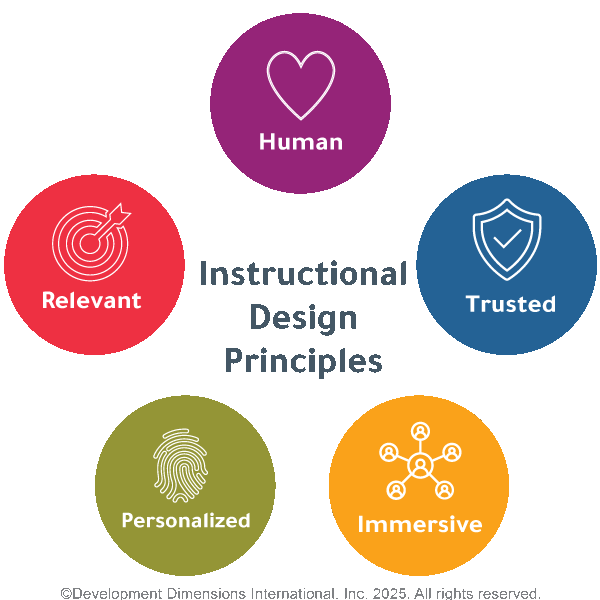Like a swinging pendulum, leadership development methods move on a spectrum between two extremes. On one side sits traditional, structured classroom learning led by instructors. On the other side is fully self-guided learning with total freedom but little direction. The best leadership development programs combine the strengths of both methods, using instructional design principles that center leaders’ needs with both structure and flexibility.
Are Learning Design Principles Making a Comeback?
In the past, instructional design leaned heavily toward the left side of the pendulum. Based on proven techniques, instructional design professionals would carefully craft learning experiences that followed specific principles and rules for learning. Often, this approach also relied on a highly knowledgeable instructor.
While structured learning has clear benefits, it can feel too rigid. This “one size fits all” approach often doesn’t allow enough room for personalized or in-the-moment learning.
As a result, companies swung the other way. Learning design took a backseat as they moved toward a looser approach where almost anything could count as training. Articles, videos, short courses, podcasts—learning was everywhere.

And to some extent, that’s true. We do learn from everything we do. But the real question is: Do these self-guided experiences lead to lasting change? The most effective learning drives real shifts in leaders’ behavior.
Rather than focus on either extreme, it’s better to ground learning in instructional design principles that put the leader’s needs first.
Whether you’re creating your own training or partnering with an external development company, you need a strong foundation for your approach. These principles apply whether you’re designing a multi-day training event or a two-minute video.
In this blog, we’ll share the instructional design principles that DDI uses to guide our leadership development approach.

Design Principle #1: Relevant
Leaders often see frameworks and examples that don’t directly relate to their daily challenges. Effective learning must address real situations and engage leaders on a practical level. This means designing learning that fits each leader—considering their unique context, growth areas, and current challenges.
Leaders also need to connect with their company’s purpose. They want to see how their growth aligns with company values, strategic priorities, and business goals.
To make content more relevant, try these simple but powerful steps:
- Bring in your company culture. Find ways to incorporate your leaders’ current situations by tying concepts to the company values or current projects. Ask learners, “Does this work at our organization? If not, why?”
- Use real examples. When introducing a topic, ask leaders to provide their own examples. Prepared examples can work, but give leaders the option to suggest others. Make it easy to tailor exercises and pull in their workplace situations.
- Know your leaders’ needs. Combine assessment with development to help leaders build the right skills to address their biggest needs. Assessments highlight growth areas and align learning with the demands of their current or future roles.

Design Principle #2: Personalized
Leaders have limited time to spend on development. DDI’s Global Leadership Forecast 2025 finds that only 30% of leaders feel they have enough time to execute their responsibilities with the depth and diligence required. So every minute spent learning must count. That’s why personalized experiences matter—and why leaders want it so much.
Many L&D teams struggle to define what personalized development really means. Does it mean each leader gets their own digital learning path? Does personalization mean that development plans are based on individual assessment results? Does it mean suggesting content based on what leaders liked before? Or, does it mean serving leaders content that helps them grow the most?
Personalized learning can take all of those forms. At DDI, we believe that personalized leadership development means addressing leaders’ unique challenges today while equipping them with future-ready skills. Leaders seek deeply tailored, timely experiences that provide insights for both their current roles and long-term potential.
However, personalized learning is not about setting learners loose in a vast content library to choose their own adventure, randomly selecting from different models, philosophies, and behaviors. And while artificial intelligence (AI) engines that recommend content can support personalized learning, they aren’t the solution on their own.
Rather, personalized learning uses data and insight to create targeted, personal experiences that resonate deeply with leaders based on their personality, experiences, preferences, and position. In short, personalization is at the heart of leader-first instructional design.

Design Principle #3: Immersive
At its core, immersive learning is learning by doing. Learners become active participants in the learning process by directly engaging with situations and challenges they can relate to. Defined by its experiential nature, immersive learning includes problem solving, case studies, simulations, and other interactive methods that allow learners to practice their skills in a safe, relevant environment.
While immersive learning helps people learn better, it also makes learning more fun and engaging. This matters because leaders are constantly exposed to a full range of engaging experiences outside of formal learning.
Emerging technologies like AI-driven simulations or virtual reality can be important tools for immersive learning. AI-driven simulations can take many forms, but one example is using AI to provide instant feedback on leaders’ responses to realistic workplace scenarios. When leaders use simulations like this, they can practice critical skills like coaching, communicating effectively, making decisions, and influencing others in a safe space, without feeling self-conscious. This helps them refine their skills and build confidence. And leaders love it.
More traditional behavioral simulations (as found in assessment centers) can also provide deeply immersive experiences. These “day in the life” opportunities let leaders demonstrate their skills in realistic scenarios, but without the consequences of real life.
At the same time, leaders also value practicing leadership skills such as coaching or delegating with peers in real time. Learning with and from others satisfies our need to connect.
When it comes to immersive learning, it’s not just about using a specific technology or singular approach. What matters is creating hands-on experiences that let employees actively practice and refine the skills that make them better leaders.

Design Principle #4: Human
This instructional design principle might seem obvious, but it’s often overlooked. In the zeal to help leaders improve, it’s easy to forget that they’re people working with other people. Many leadership challenges touch both thoughts and feelings.
Leaders bring their heads and hearts to their work, role, and every interaction. Each has their own strengths and weaknesses to manage. And they do their best to handle the expected and unexpected challenges and opportunities that fill each day.
As organizations explore new ways to develop leaders, AI-driven learning tools are becoming more common. When used effectively, AI can enhance learning through personalized experiences and instant feedback. However, it often lacks the human touch that’s essential for meaningful leadership growth. Empathy, emotional connection, and context are crucial in helping leaders build lasting skills. To bridge this gap and create effective, human-centered learning experiences, blend AI-driven insights with human guidance and connection.
At DDI, we make human connection a core part of leadership development in several ways:
- Generate empathy. Recognizing and responding to learners’ emotions—like the need to feel respected—is as important as meeting business goals. Practice emotional intelligence (EQ) to balance heart and head in a safe learning environment.
- Tap into frustrations. It’s common for leaders to encounter problems when trying new skills. Talk about these challenges and what made those skills difficult to apply.
- Tell stories. Facilitators can bring key points to life with real-world scenarios and compelling stories. Encourage learners to share their own experiences, and supplement with facilitator examples when needed.

Design Principle #5: Trusted
The last instructional design principle is more important than ever as AI evolves and the risk of misinformation grows: trusted content.
When you have a question, what do you do first? Do you turn to the web, ask AI, or check social media? It’s quick and easy, right? In seconds, you can read AI-generated summaries, browse articles, watch short videos, listen to podcasts—all offering instant answers.
But how do you know what to trust? What makes the creator an expert? How do you know the answer is right? Or that the suggested approach fits your needs?
You can’t stop leaders from searching online for solutions. But you can make sure their formal development uses scientific, data-driven methods. Leaders need to know their training will help them build skills and become better leaders. It should offer more than a few quick tips for immediate problems.
Even better—what if leaders could search within your organization for help with current problems? What if they could find answers aligned with your organizational values, strategy, and their needs? That’s the goal of truly supporting leaders through their challenges.
Using Instructional Design Principles
Every element of learning in your program may not meet all five instructional design principles. And that’s OK. Some may meet two or three, while others meet all five.
What matters most is knowing your instructional design principles and how each part of your program uses them. If something doesn’t fit within your learning design principles, ask if it really supports your overall strategy and goals.
Have a Question?
FAQ
-
What are key instructional design principles for leadership development?
At DDI, we design leadership development programs around core instructional principles that prioritize real-world skill application, personalized learning paths, and active engagement techniques to drive true behavior change.
-
Why is personalization important in leadership development instructional design?
Personalization is critical because it ensures leaders focus on the skills that matter most to their roles and organizational goals. At DDI, we use leadership assessments and success profiles to tailor development for maximum impact.
-
How does DDI incorporate active learning in leadership programs?
We incorporate active learning methods such as leadership simulations, role-plays, action learning projects, and coaching experiences. These techniques allow leaders to build critical skills through direct, hands-on practice.
-
How can organizations apply instructional design best practices to leadership development?
DDI helps organizations apply instructional design best practices by aligning learning programs to leadership success profiles, integrating real-world application opportunities, and using scalable solutions that meet learners where they are.
Topics covered in this blog

